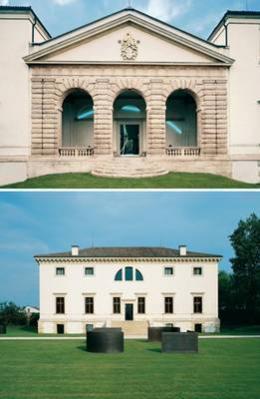 Arte Contemporanea a Villa Pisani Igino Legnaghi Francois Morellet,
Arte Contemporanea a Villa Pisani Igino Legnaghi Francois Morellet,
Villa Pisani Bonetti
Via Risaie 1
36045 Bagnolo di Lonigo (Vicenza) Italy
Phone: 0039 0444 831104
Fax: 0039 0444 835517
Contact: Manuela Bedeschi
villapisani.mostre@alice.it
www.villapisani.net
COORDINATOR PROJECT: Luca Massimo Barbero
CURATOR: Francesca Pola
OPENING: Saturday 21 June 2008 at 6.30 p.m.
EXHIBITION DATES: 21 June - 8 November 2008
OPENING HOURS: from Monday-Friday2.30 pm-5.30 pm or by appointment
Villa Pisani Bonetti a Bagnolo di Lonigo
Architetto Andrea Palladio secolo XVI
On Saturday 21 June at 6.30 pm an exhibition of works specially created for the site by Igino Legnaghi and Francois Morellet will open in Bagnolo di Lonigo (province of Vicenza), at the splendid Villa Pisani, perhaps the most outstanding of Andrea Palladio's early villas.
'Arte Contemporanea a Villa Pisani' is an ongoing project of commissions that Manuela Bedeschi and Carlo Bonetti, the current owners of the Villa, have asked Francesca Pola to curate under the supervision of Luca Massimo Barbero, with the aim of seeking a new approach to the patronage of the arts in the Veneto.
The project was launched in 2007 as a result of the owners' passion for art and their desire to revive the roles of patron and spectator; last year the project involved works by Nelio Sonego and Michel Verjux engaged in a perfectly balanced dialogue with the building designed by Palladio in and after 1541, and built in 1544 and 1545 for the patrons, the Pisani family.
This year, on the occasion of the ceremonies for the five hundredth anniversary of the birth of Palladio, two important artists of the previous generation, Igino Legnaghi and Francois Morellet, will be hosted in order to realize a new series of interventions involved in a dialogue with each other as well as in a direct and active relationship with both the architectural spaces and the historical memory of this sixteenth-century building.
The artists have worked both inside and outside the building to create an exhibition that allows visitors to see the relationship between the Villa and themselves from a different point of view: it consists of a journey through the past, present and future of vision, regarded as a physical and mental locus for the merging of various creative presences. For the Villa, Legnaghi has conceived a series of works that relate to the park surrounding it, while Morellet has created works interpreting the spaces and architectural details of Palladio's building.
Mathematical structures and proportions comprise the basis for the big metal sheets designed by Legnaghi to be scattered in the park surrounding the Villa Pisani, establishing a 'path of reflection' on its spaces and a harmonious relationship between form and life, and artistic creation and the natural dimension. In accordance with a logic of elementariness and communicative efficacy based on geometric form and technological materials, Legnaghi's sculptures draw on this relationship with the natural environment, which is the constituent element not only of the fascination but also of the very concept of Palladio's building. The large openings of the Villa's windows appear to invite those inside to enjoy an extensive view of the surrounding park in a relationship that Palladio himself intended to be significant because, for him, the natural setting was the necessary counterpoint to the formal identity of his buildings.
Morellet's project for the Villa Pisani involves a series of interventions, which, through the use of neon and in their relationship with the existing architectural elements, construct a path that allows visitors to become aware of the Villa Pisani's formal and spatial significance. A blue light sign describes a large arc crossing the whole rear wall of the loggia, echoing and, at the same time, contrasting with its monumental and very pure arched form. Behind the loggia, in the central hall, is the work entitled 'Lamentable blanc (White Lamentable)', which appears to be almost suspended in the imposing architectural void created by the height of the building's central block, while for the two cellars, the artist has created two installations consisting of neon lights that are complementary to each other.
On the occasion of the exhibition, two bilingual catalogues including texts by Luca Massimo Barbero, Francesca Pola, Igino Legnaghi and Francois Morellet, photographs of the works on display in the exhibition and bio-bibliographical notes will be published by the Associazione Culturale Villa Pisani Contemporary Art.
The exhibition is under the patronage of the Regione Veneto, the Provincia di Vicenza, the Comune di Vicenza, the Comune di Lonigo, the Pro Loco di Lonigo, the Patto territoriale area berica, C4 Centro Cultura Contemporaneo Caldogno, UNESCO Commissione Nazionale Italiana, the Istituto Regionale per le Ville Venete, the Associazione per le Ville Venete, the Comitato Nazionale per il V Centenario della nascita di Andrea Palladio (1508-2008).